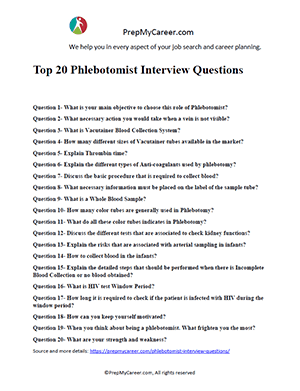Science and Technology have made various advancements in their sector. Similarly, the medical sector also has evolved itself with time. It is no longer necessary to die of any disease without any treatment. There are both government and private hospitals that are providing their services for the people regardless of their caste and community. But before getting to the conclusion there are tests to be done which help your symptoms to be matched with any of the diseases you are suffering from. So to handle this responsible and respective position here comes the role of a phlebotomist. In this article, we will be discussing mainly some of the most important interview questions that are asked in an interview for the role of a phlebotomist.

Important Interview Questions For Phlebotomist
Question 1- What is your main objective to choose this role of Phlebotomist?
Answer- For this question to be answered you must be really honest and just speak what you feel about this job profile. Also, you need to be confident about what you say.
Sample Answer: I believe that serving people is the most satisfactory job when you can bring a smile to their faces. Also, if I say professionally I was always interested to serve as a health worker and perform my duty most responsibly that also includes handling patients working to calm their anxiety or stress. So, phlebotomists have provided me the chance where I will be able to perform almost what I always wanted.
Question 2- What necessary action you would take when a vein is not visible?
Answer- This condition is mainly seen when the patient is weak or on elderly people. As a phlebotomist, I would initially use a hot washcloth on that particular area where infusion is necessary. This hot washcloth must be kept for few minutes and eventually, the veins can be visible. But there are certain cases where this procedure fails. Then I would take the patient’s hand and will swing it which will create a centrifugal force resulting in a blood flow towards the arm which will eventually dilate the veins making it visible. Lastly, if both these conditions fail then I would call the nurse in charge and will require to use some other procedures for that particular patient.
Question 3- What is Vacutainer Blood Collection System?
Answer- This blood collection system consists of a double-pointed needle, along with a plastic holder and different vacuum tubes whose surface is enclosed with rubber stoppers. It is an efficient way in the blood drawing process for tests rather than inserting a needle taking out blood and then filling it in a tube this process of vacutioner is much easier for the practitioner and also the patient.
Question 4- How many different sizes of Vacutainer tubes available in the market?
Answer– Different sizes vacutainer tube in the market are:
- 5,7,10 & 15 ml (In adults).
- 2, 3 & 4 ml (In infants).
Question 5- Explain Thrombin time?
Answer- Thrombin time is the time taken in the coagulation process or hemostatic process. This process calculates the time required for the conversion of soluble fibrinogens into fibrin.
Question 6- Explain the different types of Anti-coagulants used by phlebotomy?
Answer- Different types of anticoagulants used in this field are mentioned below:
- EDTA.
- Sodium Polyanetholessulfonate
- Potassium EDTA.
Question 7- Discuss the basic procedure that is required to collect blood?
Answer- The basic procedure that is followed during the collection of the blood sample is as follows:
- Initially, we need to tie the belt on the patient’s upper arm. The belt should be placed right 2 to 3 inches just above the venipuncture site.
- The belt is mainly used to put pressure on the veins which will help in dilating the wall of the veins.
- After the veins are visible it is necessary to examine the right place to make the puncture.
- Wearing gloves by the practitioner is always necessary.
- Always apply disinfectant in that particular area before injecting the syringe.
- Finally, we need to insert the syringe at the correct angle to take the blood out and pouring it into the vacuum tubes.
- Once the blood is taken out we just need to hold dry cotton in that particular area for few minutes to stop the blood flow.
Question 8- What necessary information must be placed on the label of the sample tube?
Answer- The sample tube must be labeled with all this basic information about the patient:
- Patient’s name and age.
- Patient gender.
- Along with the patient ID number as provided in the requisition form.
- Also, the time and date with the initials of that particular phlebotomist must be provided.
Question 9- What is a Whole Blood Sample?
Answer- This process is an immediate process where the blood is drawn out through a needle and then instantly added to an anti-coagulant. The reason behind this instant procedure is that we all know how past oxygen in the air reacts with any substance so is blood. So before it gets contaminated through any bacteria or such agents in the air or undergoes clotting for that reason this procedure is used to prevent this outcome.
Question 10- How many color tubes are used in Phlebotomy?
Answer- There are more or less 14 color tubes that are used in Phlebotomy and all these colors indicate some different tests.
Question 11- What do all these color tubes indicates in Phlebotomy?
Answer- Different colors indicate different things like:
- Red top- For Immunology and Serology testing.
- Golden top- For immunology and Serology testing, but here use of chemicals is completely different.
- Light Green top For the use of Chemical testing.
- Purple top- Hematology testing.
Question 12- Discuss the different tests that are associated to check kidney functions?
Answer- Different tests involved to test kidney functions are mentioned below:
- Creatine test.
- Urea.
- eGFR.
- Dissolved salts.
Question 13- Explain the risks that are associated with arterial sampling in infants?
Answer- Different risks that are associated with arterial sampling in infants are:
- Scarring.
- Hematoma.
- Nerve damage is also possible if the fingers of the infants are punctured.
- Veins can be collapsed if the tibial artery is damaged. This can be possible while dealing with the puncture in the medial region of the heel in the infants.
Question 14- How to collect blood in the infants?
Answer- Collection of blood in infants must be followed as the steps mentioned below:
- As infants are delicate we need to be very careful in their part.
- Initially, we must always target the heel or the foot region.
- We can try a warm washcloth that will be placed at the mark where the puncture will be made.
- The cloth should be warmed at a very decent temperature without hurting the infant say almost 35-40 degrees C.
- This is mainly done to find the capillaries.
- Then you just need to make a puncture in the heel print lines.
- After, that you just need to wipe out the first drop of blood and the next drop must be taken in the sample tube for further test.
- Lastly, it is very important to hold the cotton in that particular area to stop the blood flow.
Question 15- Explain the detailed steps that should be performed when there is Incomplete Blood Collection or no blood obtained?
Answer- Certain steps to be followed when there is no blood obtained:
- This case is mainly seen in elderly people or patients who are weak.
- So, it is necessary to change the angle and try to move it forward.
- If it is penetrated too deep it is better to bring it in the backward direction.
- The needle must be inserted at the correct angle. The needle top layer should be placed right above the vein wall.
- Also, in this case, it is better to loosen up the belt. As this may resist the flow of blood.
- Or if all these solutions do not work it is better to try any other location to draw the blood.
Question 16- What is HIV test Window Period?
Answer- This is a period in between when the patient is infected with HIV and the time required for the antibodies to appear to fight the virus. During this period the patient will be tested negative for HIV. This may take 14-21 days in some cases or may even 12 weeks in some cases.
Question 17- How long it is required to check if the patient is infected with HIV during the window period?
Answer- If the patient infected with HIV is in their window period then there are certain test that is performed:
- The first-generation test- In this case, the antibodies can be detected within 40 to 60 days of infection.
- Second generation test- In this case, the antibodies can be detected within 21-24 days of infection.
- Third generation test- In this scenario, the antibodies can be detected within 14-15 days of infection.
Question 18- How can you keep yourself motivated?
Answer- In this question, you need to be completely honest about what you think about your profession and how can keep yourself going by overcoming the hurdles in your journey.
Sample answer- I cannot see people suffering around me. So, I always wanted to provide my services for the patients and also to ease their suffering. When I will be able to perform all my responsibilities with great care and also will provide all the patients with quality healthcare. It would be a trigger, when eventually in my journey I will be saving many lives and bring a smile to their face that is how I will be motivating myself in this selfless journey of my life.
Question 19- When you think about being a phlebotomist. What frighten you the most?
Answer- I always fear piercing the needle at the wrong angle may hurt the patient. Also, I always stay worried that I do not contaminate the needle while injecting a patient. But then I believe that this fear is always necessary for you. I will tell you why? Because, when you are in fear you stay alert and the chances of errors are very less.
Question 20- What are your strength and weakness?
Answer- This question answer can differ based on different personalities. But yes you must always keep a positive approach.
Download the list of questions in .PDF format, to practice with them later, or to use them on your interview template (if you want to crack Interview):
Conclusion
The above-discussed questions and answers can increase your chance of performing better than other candidates. Also, if you have found the above article useful then do share and leave your valuable feedback in the comments.
References
Sandeep Bhandari is the founder of PrepMyCareer.com website.
I am a full-time professional blogger, a digital marketer, and a trainer. I love anything related to the Web, and I try to learn new technologies every day.
All the team management, content creation, and monetization tasks are handled by me. Together with the team at PrepMyCareer, the aim is to provide useful and engaging content to our readers.
